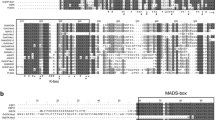Abstract
Amaryllidaceae, a monocot plant family, consists of many important ornamental bulb flower species. Chinese narcissus (Narcissus tazetta var. chinensis Roem), its flowers developed at high temperatures and bloomed at lower temperatures during the Chinese Spring Festival, is a traditional Chinese flower with high economic and ornamental value. To study its flower development, a full length cDNA containing MADS box domain from narcissus was isolated by a reverse transcription polymerase chain reaction (RT-PCR) with degenerate oligo-nucleotide primers derived from a conserved MADS-and K-box domain sequence. The 5′ and the 3′ regions of the gene were amplified using the PCR protocol for the rapid amplification of cDNA ends (RACE). The 690 bp open reading frame encodes 230 amino acid residues. A comparison of the deduced amino acid sequence of NTAG with the sequence of other MADS box proteins showed 91.3% amino acid identities with HAG (Hyacinthus orientalis). Sequence analysis and alignment showed significant similarity with other AG homologues. RNA blot analysis indicated that the narcissus NTAG gene was expressed only in reproductive organs, especially in stamens and carpels. These results indicated that the NTAG gene was an AG homologue and that the AG genes appeared to be structurally and functionally conserved between dicots and monocots.
Similar content being viewed by others
References
Bowman J L, Smyth D R, Meyerowitz E M. 1991. Genetic interactions between homeotic genes of Arabidopsis. Development, 112: 1–20
Coen E S, Meyerowitz E M. 1991. The war of the whorls: genetic interactions controlling flower development. Nature, 353:31–37
Hu Y, Wang Z, Wang Y, Bao F, Li N, Peng Z, Li J. 2001. Identification of brassinosteroid responsive genes in Arabidopsis by cDNA array. Sci. China Ser. C, 637–643
Kang H G, Joen J S, Lee S, An G. 1998. Identification of class B and class C floral organ identity genes from rice plants. Plant Mol. Biol., 38: 1,021–1,029
Kempin S A, Mandel M A, Yanofsky M F. 1993. Conversion of perianth into reproductive organs by ectopic expression of the tabocco floral homeotic gene NAG1. Plant Physiol., 103: 1,041–1,046
Kyozuka J, Shimamoto K. 2002. Ectopic expression of OsMADS3, a rice ortholog of AGAMOUS, caused a homeotic transformation of lodicules to stamens in transgenic rice plants. Plant Cell Physiol., 43(1): 130–135
Li Q Z, Li X G, Bai S N, Lu W L, Zhang X S. 2002. Isolation of HAG1 and its regulation by plant hormones during in vitro floral organogenesis in Hyacinthus orientalis L. Planta, 215(4): 533–540
Mandel M A, Bowman J L, Kempin S A, Ma H, Meyerowitz E M, Yanofsky M F. 1992. Manipulation of floral structure in transgenic tobacco. Cell, 71: 133–143
Martin W, Lydiate D, Brinkmann H, Forkmann G, Saeddler H, Cerff R. 1993. Molecular phylogenesis in angiosperm evolution. Mol. Biol. Evol., 10: 140–162
Mena M, Ambrose B A, Meeley R B, Briggs S P, Yanofsky M F, Schmidt R J. 1996. Diversification of C-function activity in maize flower development. Science, 274: 1,537–1,540
Mizukami Y, Ma H. 1995. Ecotopic expression of the floral homeotic gene AGAMOUS in transgenic Arabidopsis plants alters floral organ identity. Cell, 71: 119–131
Mou Z, Wang X, Fu Z, Dai Y, Han C, Ouyang J, Bao F, Hu Y, and Li J. 2002. Silencing of phosphoethanolamine N-methyltransferase results in temperature-sensitive male sterility and salt hypersensitivity in Arabidopsis. Plant Cell, 14(9): 2,031–2,043
Mou Z, He Y, Dai Y, Liu X, Li J. 2000. Deficiency in fatty acid syntheses leads to premature cell death and dramatic alterations in plant morphology. Plant Cell, 12(3): 405–417
Munster T, Pahnke J, Di Rosa A, Kim J T, Martin W, Saedler H, Theissen G. 1997. Floral homeotic genes were recruited from homologous MADS-box genes preexisting in the common ancestor of ferns and seed plants. Proc. Natl. Acad. Sci. USA, 94(6): 2,415–2,420
Ng M, Yanofsky M F. 2000. Three ways to learn the ABCs. Curr. Opin. Plant Biol., 3(1): 47–52
Pnueli L, Hareven D, Rounsleay S D, Yanofsky M F. 1994. Isolation of the tomato AGAMOUS gene Tag1 and analysis of its homeotic role in transgenic plants. Plant Cell, 6: 163–173
Purugganan M D. 1997. The MADS-box floral homeotic gene lineages predate the origin of seed plants: phylogenetic and molecular clock estimates. Mol. Evol., 45(4): 392–396
Riechmann J L, Meyerowitz E M. 1997. MADS domain proteins in plant development. Biol. Chem., 378: 1,079–1,101
Rounsley S D, Ditta G S, and Yanofsky M F. 1995. Diverse roles of MADS box genes in Arabidopsis development. Plant Cell, 7: 1,259–1,269
Rutledge R, Regan S, Nicolas O, Fobert P, Cote C, Bosnich W, Kauffeldt C, Sunohara G, Seguin A, Stewart D. 1998. Characterization of an AGAMOUS homologue from the conifer black spruce (Picea mariana) that produces floral homeotic conversions when expressed in Arabidopsis. Plant J., 15(5): 625–634
Tsuchimoto S, Van der Krol A R, Chua N H. 1993. Functional analysis of petunia floral homeotic MADS-box gene pMADS1. Genes Dev., 7: 1,214–1,228
Weigel D, Meyerowitz E M. 1994. The ABCs of floral homotic genes. Cell, 78: 203–209
Wolfe K H, Gouy M, Yang Y W, Sharp P M, Li W H. 1989. Date of the monocot-dicot divergence estimated from chloroplast DNA sequence data. Proc. Natl. Acad. Sci. USA, 86(16): 6,201–6,205
Yanofsky M F, Ma H, Bowman J L, Drews G N, Feldmann K A, Meyerowitz E M. 1990. The protein encoded by the Arabidopsis homeotic gene AGAMOUS resembles transcription factors. Nature, 346(5): 35–39
Author information
Authors and Affiliations
Corresponding author
Rights and permissions
About this article
Cite this article
Wang, Zk., Gao, J., Li, Lb. et al. Isolation and characterization of the AGAMOUS homologous gene NTAG in Chinese narcissus (Narcissus tazetta var. chinensis Roem). For. Stud. China 8, 21–26 (2006). https://doi.org/10.1007/s11632-006-0004-9
Received:
Accepted:
Issue Date:
DOI: https://doi.org/10.1007/s11632-006-0004-9



